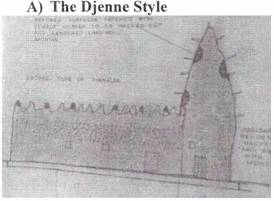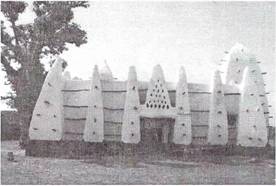HISTORY
Most of the communities of the regions of Northern Ghana, especially the Northern Region, are Muslim. Islam, which first entered Africa through Egypt in the 10th Century AD, progressed from Egypt towards the west and the south at the same time as the trans-Saharan slave and gold trade routes. In Ghana, these trade routes were used by Mande warriors, Islamic Traders and Missionaries. Occasionally, these routes were marked by incursions by the Almoravids, a Berber Dynasty, which played a major role in the spread of Islam in the area. At rest points for the Islamic traders along the routes, and in conquered territories people were converted to Islam and this led to the construction of mosques in the Northern part of Ghana. Some of these mosques still exist today and they date as far back as the 17th Century AD.
ARCHITECTURAL STYLE
Architecturally, the ancient mosques belong to the Sudanic-Sahelian styles, which can also be found in Burkina Faso and Cote d'Ivoire. This style is characterized by the fusion of the vernacular construction teclmiques with the architectural rules which have to be respected when building a mosque. Two major styles of mosques were the Sudanic style and the Djenne Style.
 |
The Djenne style features a rectangular building
without buttresses. It has load bearing walls
and a flat roof surrounded by a parapet. It
usually has one tower at one end of the
rectangle. A typical example of this mosque is
the Wuriyanga Mosque located in the Upper
East Region, a town near the Northern Region
and Togo borders, lying between Garu in the
Upper East Region and Nalerigu in the
Northern Region.
|
|
|
|
|
B) The Sudanic Style |
|
 |
The Sudanic style, though rectangular, has
timber frame structures or pillars supporting
the roof. It is characterized by two pyramidal
towers (the minaret and the mihrab), and by a
number of irregular shaped buttresses, with
pinnacles projecting above the parapet, which
enlivens the mosque's elevations. An example
of this style is the Larabanga Mosque located
in the Northern Region, near Damongo on the way to Mole Park.
|
SOCIAL ROLES OF THE MOSQUES
Apart from their usual role as Friday prayer grounds, the ancient mosques also serve as places of pilgrimage to the Muslim communities in the country. On eventful days, a lot of faithful worshippers gather at these mosques for prayers and listen to Koranic readings. Private readings are also organized on request for individuals who have serious problems to solve, or who seek spiritual protection on their ventures. In return for the readings, the Chief Imam normally requests the sacrifice of a cow and other donations for the community.
RESTORATION OF THE MOSQUES
GMMB has vested interest in the preservation of these monuments. It participates actively in programmes of the World Monuments Fund, CRATerre, ENSAG, UNESCO, and NGOs as well as individuals for the restoration of these mosques. The communities play a great role in the restoration of the mosques.
As a result of successive restorations, which have guaranteed the survival of these mosques, the shape of the walls and the decoration details have evolved. At the same time, the action of prevailing winds and rains on walls have fashioned out natural forms fitting to this earth architecture. This constant evolution of the monument, since its construction, is certainly responsible for its undisputable peculiarity.
-
Larabanga Mosque
The Larabanga Mosque is thought to be the oldest mosque in Ghana and West Africa. It is popularly referred to as the ‘Mecca of West Africa’, because of its rich historical and architectural values. The dimensions of the mosque are approximately 8m by 8m. The Larabanga Mosque made it to the World Monuments Fund’s List of 100 Most Endangered Sites. There is some controversy over when exactly the mosque was built, and who built it. The mosque is thought to date back to 1421. It is believed that an Islamic trader called Ayuba, who was travelling through the area, built the mosque. According to one story, Ayuba slept in the area and had a dream in which he was instructed to build a mosque. When he woke up the next morning, the foundation of the mosque had mysteriously appeared, so he continued with the construction until the mosque was complete. The mosque is made of mud and stick, in Sudanese style. Right next to the entrance is a large baobab tree, under which Ayuba’s remains are buried. The mosque has four entrances: one each for the village chief, men, women, and the muezzin who leads the call to prayer. The mosque houses a very old Koran which is thought to have been delivered from heaven to an Imam called Bramah, around 1650, after he had prayed hard for a Koran. The mosque is located in a small predominantly Muslim town, called Larabanga, near Damongo in the Western Gonja District in the Northern Region. The official viewing fee for the mosque is GH¢ 1.00. Non-Muslims are not allowed to enter the mosque.
-
Nakore Mosque
Nakore Mosque is in the Upper West Region.
-
Banda Nkwanta Mosque
Located in West Gonja District in the Northern Region, this mosque has very tall parapets.
-
Maluwe Mosque
Maluwe Mosque is in the Northern Region, on the way to Bole, in the West Gonja District.
-
Wuriyanga Mosque
This 19th Century mosque is in the Upper East Region, beyond Garu, near the Togo Border. Restoration works have been undertaken by the local community.
-
Wechiau Mosque
Wechiau Mosque is in the Upper West Region.
-
Dondoli Mosque
This 19th Century mosque is in Wa, the capital of the Upper West Region.
-
Dakrupe Mosque
This is a 19th Century mosque located in the Northern Region, near Larabanga.
-
Bole Mosque
Bole Mosque is in West Gonja District, in the Northern Region.





